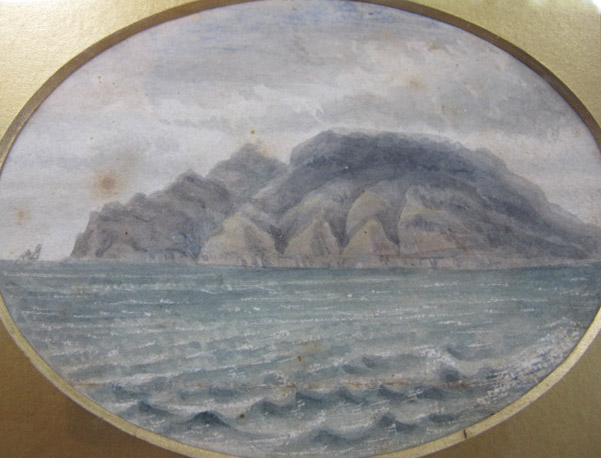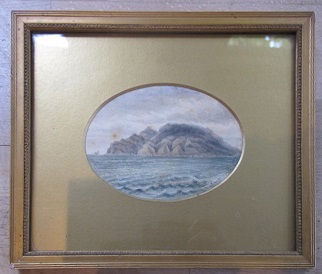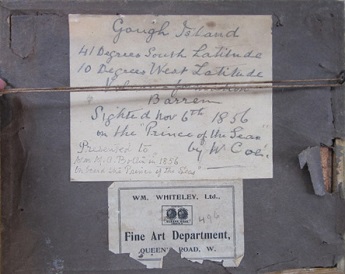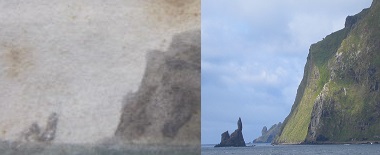Sale of an 1856 Painting of Gough Island
A fascinating early watercolour of Gough Island painted from a passing clipper ship came up for sale on eBay in August 2016, and was sold to an Italian bidder. We are grateful to both the vendor and the buyer for their permission to reproduce the following images of the picture.

Watercolour of Gough Island painted by W.Coe, 1856.
This small original watercolour measures approx 125mm x 95mm, and the framed picture is 225mm x195 mm. The picture is showing its age, with some fogging and wear to the gilt frame.
 The watercolour of Gough Island in its frame. |
 Information about the picture on the back of the frame. |
A printed label on the back of the frame indicates that the picture was at some point framed or sold by the Fine Art Department of Wm.Whiteley's department store, Bayswater, London. It also has the following information written on the back:
Gough Island
41 Degrees South Latitude
10 Degrees West Latitude [sic]
Volcanic formation
Barren
Sighted Nov 6th 1856
on the Prince of the Seas
by W.Coe.
Added in a different hand:
Presented to
Mrs M. A. Bolton in 1856
On board of the "Prince of the Seas"
We have been unable to find any information about W.Coe or others works by him, but he was evidently a talented amateur artist.
Regarding what the painting depicts, Sir Martin Holdgate writes:
I think the rock on the left is Church Rock and the painting is from off North Point. The pointed peak on the skyline left of centre is probably Mount Argus and Camp Glen is the valley opening in the centre of the view. The bluff on the right would be the end of the ridge that rises to Nigel's Cap (whose summit would not be visible from the supposed viewpoint) and the slopes dipping to the right would fall into Battle Bay. However the landscape is distorted: the towering cliff that rises from North East Point inshore from Church Rock has been greatly diminished and I suspect that for aesthetic reasons the artist has made the island appear much narrower than it is!
There is a photograph of Church Rock and North East point facing page 144 of my book 'Mountains in the Sea' that can be compared with the left hand part of this painting. The pointed top that I take to be Mount Argus is clear in both.

Detail showing the distinctive Church Rock off North East Point, compared with a modern photograph.
The Prince of the Seas was a clipper ship built by James Smith & Sons, St.John, New Brunswick, Canada in 1853. She mostly plied the routes between Engand and Melbourne, Australia, until November 1861, when she was destroyed by fire while unloading cargo at Hobson's Bay, Melbourne. The Gough picture was painted on a voyage which, according to contemporary Australian newspapers sailed from London on the 13th September 1856 under Captain J.A.Wilson and arrived at Melbourne on the 10th December, a voyage of 88 days. She was rated at 1427 tons, and was carrying 28 cabin and 110 intermediate and steerage passengers.
